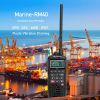Making a distress call

The distress call Mayday may be used only if the boat is threatened by grave and imminent danger – for example, sinking or on fire – and immediate assistance is required. This distress call has absolute priority over all other transmissions and may be transmitted only on the authority of the skipper or the person responsible for the safety of your vessel.
A Mayday call on one of the distress frequencies will attract the attention of land stations and other vessels in your area. Stay calm, explain the problem and give position and distress information clearly.
Distress or urgency
When transmitting a distress or urgency message, stay on VHF channel 16 or 27.88mHz and do not change unless directed to by the local marine radio station – the rescuing vessel will communicate with you on that channel.
- Specify the nature of assistance you need.
- Follow directions of rescuers.
- Follow any instructions Sea Rescue or the rescuing vessel give you.
- Notify Sea Rescue if the situation changes or the danger has passed.
Silence periods
To increase the chances of a weak distress transmission being received, three[1]minute periods of radio silence are observed on the hour and half hour on distress channels.
With the exception of distress traffic, all transmissions must cease during silence periods.
Mayday procedure
“Mayday, Mayday, Mayday”
“This is [vessel name and/or call sign if you have one]” (spoken three times)
“Mayday [vessel name and/or call sign if you have one]”
“My position is ... [Details of the ship’s position]”
“My vessel is ... [Nature of distress and assistance required is identified]”
“I have ... [Other information including number of persons on board]”
This call can be repeated as often as necessary until answered. If no answer is received on distress frequencies, repeat the call on any frequency which might attract attention.
Mayday relay
If you hear a distress (Mayday) call and a coast station does not answer, render assistance where reasonable or attempt to relay the message.
Pan Pan urgency call
The urgency call should be used when the distress call cannot be justified but there is an urgent message to transmit concerning the safety of the vessel or the safety of a person (for example, mechanical breakdown, medical emergency or a man overboard).
Pan Pan procedure
“Pan Pan, Pan Pan, Pan Pan”
“Hello all stations, Hello all stations, Hello all stations”
“This is [vessel name and/or call sign if you have one]” (spoken three times)
“My position is ... [Details of the vessel’s position]”
“I require... [Details of assistance required and other information]”
Urgency calls can be made on a distress frequency or any other frequency which may attract attention






